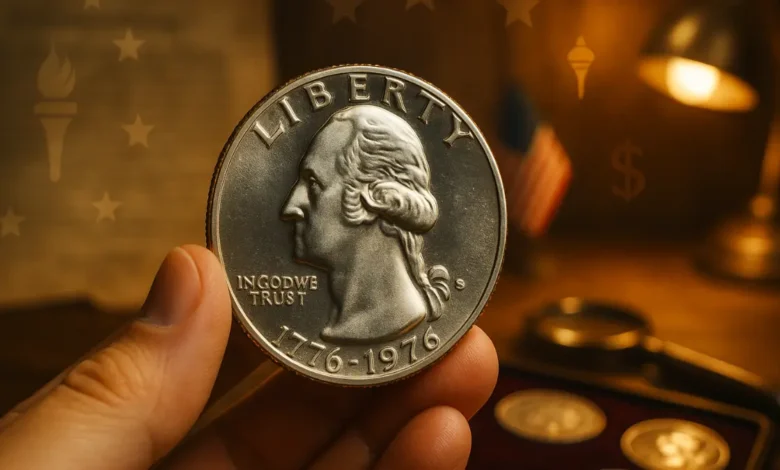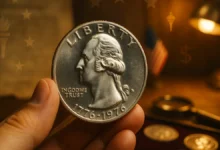The Story Behind the 1776 to 1976 Quarter Dollar

Discover the fascinating story, design, and hidden value of the 1776 to 1976 quarter dollar — America’s iconic bicentennial coin that celebrates freedom, history, and collectible charm.
The 1776 to 1976 quarter dollar is one of the most recognized coins in American history. Commonly known as the “Bicentennial Quarter,” this coin was minted to honor the two-hundredth anniversary of the United States’ independence. It replaced the traditional Washington quarter design temporarily during the mid-1970s, marking a historic and symbolic celebration that united patriotism and artistry.
The U.S. Mint released the coin as part of a broader bicentennial program that included the quarter, half dollar, and dollar. Each featured a special design that captured the spirit of the nation’s founding. While the obverse side of the quarter retained the classic profile of George Washington, the reverse was redesigned to feature a colonial drummer — a striking departure from the usual eagle motif.
Collectors immediately noticed that this coin was more than a typical piece of change. It was a circulating tribute to liberty, courage, and the endurance of the American experiment. The dual date “1776-1976” on the obverse stands as a reminder that the nation had reached a milestone moment: two centuries of independence. Even decades later, the coin continues to capture fascination as both a historical artifact and a collectible with charm and potential value.
1776 to 1976 Quarter Dollar Design, Composition, and Meaning
The design of the bicentennial quarter holds deep symbolism and thoughtful artistry. On the obverse, George Washington’s left-facing profile remains untouched, accompanied by the inscriptions “LIBERTY,” “IN GOD WE TRUST,” and the dual date “1776-1976.” This combination merges tradition with commemoration — a familiar face marking an extraordinary event.
The reverse is what makes this coin truly memorable. It features a colonial drummer boy standing proudly with a victory torch to his left, surrounded by thirteen stars representing the original colonies. This design symbolizes vigilance, freedom, and unity. It evokes the imagery of revolution, calling back to the early patriots who fought for independence. The words “UNITED STATES OF AMERICA” and “E PLURIBUS UNUM” frame the design, culminating in “QUARTER DOLLAR” at the bottom.
Physically, the coin’s specifications mirror the standard Washington quarter of its time. It measures about twenty-four millimeters in diameter and weighs roughly five and a half grams. Its metal composition is copper-nickel clad — a copper core sandwiched between layers of copper and nickel. The circulation versions were not made of silver, but special collector editions were struck in forty percent silver for proof and mint sets, giving them a brighter sheen and higher desirability.
Every detail, from the torch’s flame to the drummer’s determined expression, was created to echo the founding spirit of America. The quarter is not just currency — it’s art in your pocket, a small metallic reflection of freedom.
Minting and Circulation History
The bicentennial quarter was officially authorized by Congress as part of the United States’ national celebration of two hundred years of independence. The Mint began producing the coins in 1975, continuing through 1976. Every quarter struck during that period bore the dual date “1776-1976,” regardless of the actual year of production.
The coin was minted at three primary facilities: Philadelphia (no mint mark), Denver (marked with a “D”), and San Francisco (marked with an “S”). The San Francisco mint primarily produced proof and silver collector editions, while the others produced circulation strikes.
Hundreds of millions of these quarters were released into everyday commerce. They were intended not just for collectors, but also to circulate widely as a national commemoration. Many Americans saved them as keepsakes, while others used them like ordinary change. Because of this, most bicentennial quarters today show signs of wear, but those kept in pristine condition remain highly sought after.
Despite the high mintage numbers, truly uncirculated or high-grade examples are far less common than one might expect. Over time, the majority entered circulation and suffered from scratches, discoloration, or dulling of detail. Collectors value the uncirculated versions for their luster, sharp strike, and clear definition of the drummer design.
Varieties and Rare Versions
While the bicentennial quarter is common, several varieties and errors make certain examples much more valuable. The first major difference lies in the mint mark. Philadelphia coins have no mint mark, Denver coins bear a “D,” and San Francisco coins have an “S.” The “S” proof coins are particularly notable because some were made in silver, making them collectible and worth more than face value.
There are also a few fascinating minting errors that have become legendary among coin collectors. One of the most famous involves a double-die error, where design elements appear slightly doubled, especially in the lettering or date. Another involves a filled mint mark, where a small amount of debris caused the “D” to appear faint or missing.
In extremely rare cases, coins were struck on the wrong planchet — meaning they were accidentally made on blanks meant for other denominations. Such coins are highly prized, with some selling for thousands of dollars at auction. There are also silver-clad quarters mistakenly released into circulation, which now command significant premiums.
Other unusual traits include die cracks, misaligned strikes, and beautiful natural toning. Coins that developed a rainbow-like coloration through natural oxidation can be very desirable for their visual appeal. In numismatics, beauty, rarity, and condition often combine to determine real value — and the bicentennial quarter offers examples of all three.
Value and Collectibility
The big question everyone asks is: how much is a 1776 to 1976 quarter dollar worth? The answer depends entirely on the coin’s condition, rarity, and metal composition.
In circulated condition, most bicentennial quarters hold only modest value, typically just above face value. However, uncirculated examples or proof versions can be worth more. The average collector-grade coin in mint state may sell for a few dollars, while exceptional specimens — such as flawless mint state or proof silver editions — can reach much higher prices.
Some graded coins in pristine condition have sold for hundreds or even thousands of dollars, especially if they exhibit unique features like doubled dies or planchet errors. The most valuable examples are typically those that combine rarity and condition, such as a high-grade silver proof or an error coin certified by a professional grading company.
Still, the coin’s true charm lies in its story. It connects generations of Americans to a shared moment of history. Whether worth a few cents or a few thousand dollars, every bicentennial quarter holds meaning as a tribute to two centuries of freedom.
How to Identify and Evaluate Your Quarter
If you find a 1776 to 1976 quarter and wonder if it’s special, start by examining it carefully. Look for a mint mark under Washington’s portrait. A plain coin without a mint mark came from Philadelphia, while a “D” means Denver and an “S” marks San Francisco.
Next, study the condition. A bright, shiny coin with no scratches, dullness, or wear is considered uncirculated. Coins in proof condition have a mirror-like surface and are often sold in sets, so they are easily recognizable.
Check for anomalies like doubling in letters, missing mint marks, or striking errors. Any unusual feature could indicate an error coin. Weighing the coin can also help determine if it’s silver — silver-clad versions weigh slightly more than copper-nickel clad coins.
If you think your coin is valuable, consider sending it to a professional grading service such as PCGS or NGC. Certified coins are easier to sell and generally command higher prices because buyers trust their authenticity and grade.
Collecting and Storing Bicentennial Quarters
Collecting bicentennial quarters is one of the most rewarding introductions to numismatics. Because these coins are plentiful yet full of history, they make an ideal starting point for beginners and a nostalgic pursuit for experienced collectors.
You can build your collection in several ways. Some collectors aim for a full set of each mint mark — Philadelphia, Denver, and San Francisco — while others focus on proof or silver examples. Many enjoy the thrill of hunting for high-grade uncirculated coins in circulation or rolls from banks.
Proper storage is crucial to preserve condition. Coins should be kept in acid-free holders, coin flips, or capsules that are free of PVC plastic. Handle coins by the edges to avoid leaving fingerprints, and store them in a cool, dry place to prevent tarnish or corrosion.
For higher-value coins, consider storing them in air-tight capsules or slabs provided by grading companies. A small investment in preservation goes a long way in maintaining both aesthetic and monetary value.
Market Insights and Long-Term Potential
While most bicentennial quarters are not rare, the coin remains a cornerstone of American collecting. Its value is bolstered by its cultural importance, and its unique design ensures it will never fade from numismatic conversation.
Market trends show steady interest, particularly in top-graded specimens or coins with special attributes like errors and silver composition. The most desirable pieces are those certified in near-perfect mint state, which often achieve premium prices at auction.
Silver proofs are especially appealing, as they combine collectible significance with intrinsic metal value. As silver prices fluctuate, so does the market for these coins. Beyond the monetary aspect, however, the 1776-1976 quarter continues to attract collectors because of its design, history, and nostalgic charm.
It is likely that this coin will continue to grow in symbolic importance over time. Even if not every piece becomes highly valuable, its place in American culture is already priceless.
Tips for Buyers and Sellers
If you are buying a bicentennial quarter, research current market prices and know what to expect. Avoid paying inflated prices for common coins unless they are in certified high grade or have verified errors. When possible, buy from reputable dealers or auction platforms that offer guarantees of authenticity.
For sellers, presentation and documentation matter. Clean photographs, clear descriptions, and grading certificates add trust and visibility. If you own a coin that you believe could be valuable, consider having it appraised by a professional numismatist before selling.
Patience also plays a role in the coin market. Sometimes, values appreciate gradually as public interest cycles through collectibles and historical themes. Holding onto pristine examples can pay off in the long run.
FAQs about the 1776 to 1976 Quarter Dollar
What is the 1776 to 1976 quarter?
It’s a commemorative quarter released for America’s Bicentennial, featuring a colonial drummer on the reverse and the dual date 1776-1976 on the obverse.
Is it made of silver?
Most are copper-nickel clad, but special proof versions from the San Francisco Mint were made in forty percent silver.
How much is it worth?
Circulated versions are usually worth around their face value, while uncirculated or silver proofs can range from a few dollars to hundreds depending on condition and rarity.
What makes a bicentennial quarter rare?
Error coins, silver strikes, or coins in exceptionally high grades are rare and valuable. Variants like double dies or filled mint marks are especially prized.
How can I tell if mine is valuable?
Check the mint mark, look for unusual features, and inspect its condition. If it appears pristine or unique, a grading service can confirm its value.
Can these coins still be spent?
Yes, they remain legal tender and can still be used as regular quarters, though collectors prefer to keep them in good condition rather than spend them.
Why do collectors love these coins?
They blend history, design, and nostalgia — tangible pieces of America’s 200th birthday that anyone can hold, study, and admire.
Conclusion
The 1776 to 1976 quarter dollar stands as one of the most beloved and symbolic coins in American history. It represents more than just twenty-five cents — it embodies a nation’s journey, freedom, and creativity. The drummer boy design captures the rhythm of revolution and the triumph of unity, while the dual date marks a proud milestone in time.
Whether it’s a circulated coin found in loose change or a pristine silver proof tucked away in a collector’s case, each bicentennial quarter tells a story. It connects everyday life to the ideals that shaped a nation.
For collectors, historians, and everyday Americans alike, the 1776 to 1976 quarter is a timeless keepsake — a reminder that even something as small as a coin can carry the heartbeat of history.

